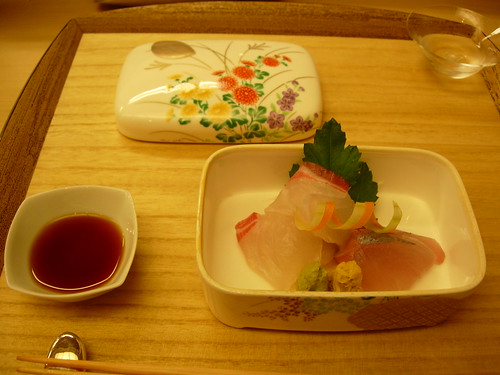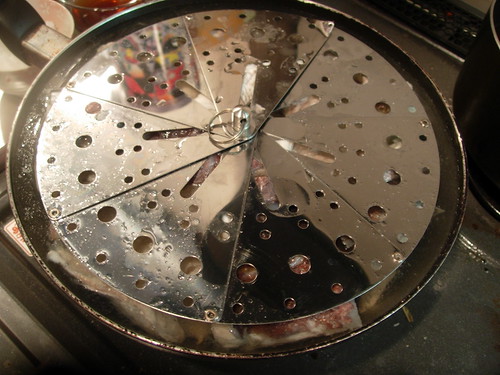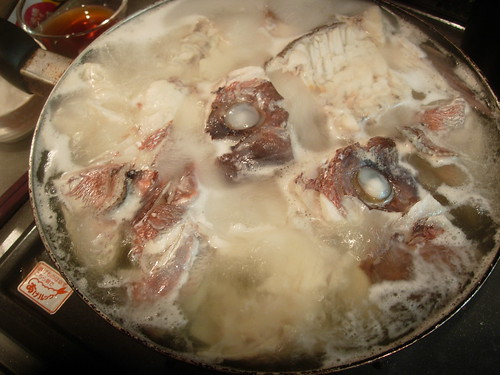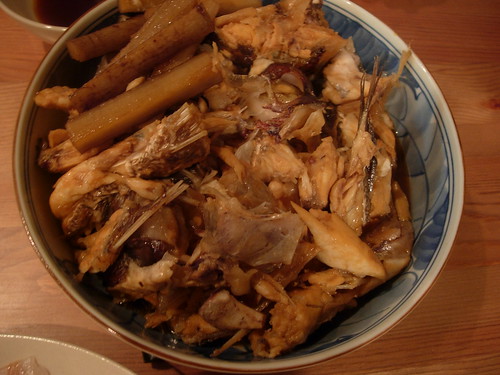I'd like to share with you a classic Japanese home recipe that is cheap, delicious, exotic, and perhaps a little disturbing. Right up front, I'm going to call for help, though: the main ingredient isn't usually available as such in America, at least not on the East Coast, so substitution is necessary.
Brace yourself, some of this may get a little ugly.
Tai no Ara Taki (鯛のあら焚き): Bream-Bits Kindling
Tai (鯛), or sea-bream, is the king of fish in Japan. It's got a distinctive sweet taste, and it holds up well in an enormous range of different cooking types: raw, poached, broiled, simmered, etc. Its many parts are generally good eating as well, and to top it off it's pretty. This one looks rather small; the big ones are a good 2 feet long.
Once you've gracefully removed the fillets from the bones, though, why waste a good thing? What you have left is the ara, the bits: head, collar, fleshy backbone. There's good flavor there, and firm meat, so let's make something good out of it.
The name of this dish, the bit about “kindling” (taki), comes from the way it's cooked. Not that you light it on fire, but you put it on a bed of sticks of gobō (burdock) that look kind of like a pile of kindling. And then you simmer the heck out of the fish bits.
The end-result is a plate of bits with the head-halves on top, with a little gobō as a garnish, in a puddle of thick, rich, brown sauce. You sit there with chopsticks—and pretty soon your fingers too—and pick all the succulent parts out of the bits.
Sound gross? You'd be surprised. It's delicious.
What's more it's cheap, easy, and fairly quick.
The Fish
The first step, of course, is to acquire your fish. Tai aren't cheap, if they're any good, being the king of fish and all that. A big good one can run you more than $100 here... a lot more. But a decent one can be down around $25. You have to remember, from this you're getting two fillets as well as the bits for making this dish. One fillet you make into slices for the nabe pot, and the other you trim as sashimi, and all that's left is the bits, which you now turn into this wonderful side-dish. Here's one presentation of tai sashimi, which I had at Roan Kikunoi.
Of course, in America you can't get tai off the West Coast, at least not that's really worth eating. Certainly I wouldn't make sashimi out of it. So you've got two basic choices: buy a whole comparable fish, or convince the fishmonger to sell (or preferably give) you the heads.
I'm betting that if you cozy up to your fishmonger, he'll just give you the heads, as they're garbage to him. If we all can figure out an appropriate few fish for the purpose, this makes the dish dirt-cheap. In Japan, you can buy heads and bits for this purpose, but in the U.S. they throw them away as a rule.
Which fish? Err... that's where it gets tricky.
You need a firm, white-fleshed fish: salmon (red) or mackerel (blue) won't work. Salmon doesn't have enough taste, and mackerel has too much. You want a head that has lots of bits of meat and flesh to eat, and here my encyclopedias and such are no use, because they don't talk about this very much. Maybe a relative of the sea bream (Pagrus major, red Pacific seabream)?
I don't know. I'm going to proceed from here as though you have a tai on hand, and hope you'll try it with what's local and let me know.
The Head
So now you have a fish head. Ick!
No, wrong answer. The right answer is, "split it." Here's how:
CLICK THIS LINK
You now have your fish-head, split, possibly cut into medium chunks.
If you have a meaty backbone, shear off the part that still has skin up at the top and bottom. Then cut the backbone into chunks.
Put a big saucepan full of water over high heat and let it get close to a simmer, i.e. when little bubbles are definitely forming on the bottom of the pan and there is real steam rising. This is the point when you think, “it'll boil any second now,” creating the adage about a watched pot.
Drop in the fish, bring to a rapid boil over as much heat as you can, and then move the pieces into a big pot of ice water.
Once the fish is definitely cool, even cold, feel the surfaces all over for any blood clots or remaining scales. This is your last chance to scale, so make good use of it. A few scales are okay in this dish, but the fewer the better—and no scales is definitely excellence.
The Kindling
For one fair-sized tai head, you need one big or two medium stalks of gobō (burdock), which you can get at a surprising range of stores these days. If unsure, get it from an Asian market, which is sure to have it. It should be cheap: it's a destructive weed in America, so eat lots. It looks like this.
Scrub the burdock, preferably under running water, with a coarse plastic scrubber like you'd use for a nonstick pan. You want to get all the dirt off, and it can be pretty deep.
Cut the burdock lengthwise into quarters, then in about 2-inch lengths.
Rinse well in water and drain. Pour into a big, deep skillet or wide saucepan.
Arrange the fish bits on top, with the eyes upward.
At this point you can stop, cover the skillet with plastic, and refrigerate for a good 12 hours or so. Fish heads are perishable, of course, so you don't want to go too long, but this isn't a fine-detail sort of dish.
Cooking the Dish
About 60 minutes or so (and there is considerable latitude here to work earlier) before serving, add 400cc water and 400cc of drinkable sake. It doesn't have to be anything grand, but salted cooking sake is out. Put on a drop-lid, which should cover everything and be slightly covered with liquid. Add water if necessary.
For this I've used a folding drop-lid available at any hardware or home-good store here for about $2. You could also use a smallish pot-lid, a dinner-plate, or even a couple of sheets of paper towel. The dinner plate will be hard to lift, and the towel even more so, but all of these things work. The point is that this will hold the stuff under the liquid for a preliminary cooking.
Now bring the heat to medium and wait until the stuff comes to a true boil—not just a simmer, but a proper boil. Remove the lid—you won't use it again here.
Skim the white scum.
Add 5 generous Tb sugar and 50cc mirin; if you cannot get real mirin, as is likely, use 45cc sake and another Tb sugar—brown sugar would be lovely here. Shake the pan around a bit to distribute, and baste the fish with the liquid. Boil fairly rapidly—medium-high heat—until the liquid is reduced by about half, basting now and again.
Add 60cc soy sauce, or preferably tamari, but either will do fine. Keep boiling until the liquid is starting to turn into a syrup, basting fairly often.
Before it gets there, grate a big chunk of peeled ginger on the finest grater you've got, held over a bowl. Squeeze the gratings over the same bowl through a fine-meshed strainer. You should have fair bit of ginger juice.
When the liquid is turning to syrup, the bubbles will start getting fatter, the sound of the pan will change, and when you lift the pan and shake a bit, there won't be all that much liquid left.
Add the ginger juice and shake it around a bit, then baste vigorously as the sauce gets shiny and, well, sauce-like.
When it gets to this point, remove from heat. Put the bits in a soup plate or the like, garnish with a bunch of the burdock on the side in a clump or something, and then pour on the sauce.
Yum! Fish Heads!
To eat, just pick up an appetizing-looking bit and eat anything that isn't bone, munching and sucking as you go to get all the goodness out.
I know, sounds gross, but honestly it's wonderful. And if you can get fish heads for free or very, very cheap, as I suspect you can, you can make this dish for very little. What's more, it can sit for days and be picked at cold, lukewarm, or nuked-hot; it won't be as good as freshly-made, but it'll be good.
Conclusion
Now I want all of you to run right out and try this. The big question is the fish: what's white-fleshed, firm, flavorful, and fairly local? If there's a choice, what will the fishmonger give you for free? Now make the dish and tell me how it tastes, and whether the flesh is still firm enough to make it worth eating. I want you to figure it out, because I'm going to come back to the East Coast and want to make this (my wife loves this), and I want somebody else to have done the experimenting to figure out the right fish for the purpose.




7 comments:
Simmered fish heads sounds a bit much, but they really are good! It took me a lot of years to give them a chance. Glad to see you and enjoying them!
Yep, they're really excellent -- and cheap. Incidentally, I am informed that U.S. cooks can try Gulf sea bream, tilapia, or related fish, and should have good results.
Hey Chris,
though you might not remember this 1-year-old blog entry anymore, I'd like to say thanks for the great explanation.
When searching for "simmered fish head" (having forgotten the Japanese name), I came to your site. And inspired by the delicious looking photos, I tried it out immediately. Well, the supermarket didn't have 鯛 today, so I used ... ahhh, damned, I already threw away the package, and I didn't recognize the kanji. It probably was something from the snapper family.
Anyway, the taste was delicious, pretty much like at the restaurant where I ate it the last time.
I just wondered what the very first step, "blanching" the head, is for. Ever tried it without this step?
--Kai
Kai,
First of all, remember that there are lots of fish in the tai family: amadai, medai, and so on. The true tai has the advantage of being sweeter and considerably meatier on the head, but it's pricey.
Blanching any kind of bones does a couple of things, and with fish there's a third. First, blanching gives a preliminary push to make the proteins coagulate; this keeps your ultimate dish clear instead of skummy/greasy. Second, blanching removes blood and some other stuff that can make a stock or sauce bitter. With fish, these same points also mean that a preliminary blanching removes a lot of the "fishy" taste and smell. I'd also note that if you haven't been perfectly successful about removing the scales and you wanted to be, the blanching will tend to help a bit.
Chris,
thanks for your fast & helpful answer.
First, something funny about the fish: This morning I took the shop's receipt with me to the lab ... somehow, the katakana didn't make much sense to me. But people told me that the XXXマダイXXX stands for 真鯛, so I got tai indeed. Surprise! :-)
More important, about the blanching: Again, thank you! Your explanation makes perfectly sense. My first thought was that the blanching will harden the fish meat, thus hindering the sauce to flavour the meat, up to some degree. So, no experiments here, I will follow your recipe again the next time, step by step.
I'm just wondering which kind of fish to use once I'm back in Germany ... but that's not your problem (and you even gave some hints at the end of your post). I'll probably post here if I found a good substitute - but luckily, this will have to wait a bit longer, still having 2 more months in Japan! ^^
Kai,
The ideal fish is white-fleshed, sweet, firm, and thick-boned. With the exception of the last point, the Dover Sole would be the ideal -- for which reasons it's very popular and become horribly expensive. You might see if you can figure out which relatively inexpensive North Sea fish are considered best for making soup and stock, because that'll cover the flavor end of things. If you do find a good Atlantic fish for this, please post it!
On the subject of blanching, it does slightly firm the flesh, yes. The effect on sauce-absorption is trivial, however. A good comparison here would be a braise with pork or beef: you sear the outside first, to get a nice flavor, and the effect on the braising process itself is trivial.
Chris,
OK, good point with the sauce-absorption, I see. Maybe I was thinking too much of this one Iron Chef episode ("sushi battle"), where a chef prepared Edomae Zushi, and one time blanching the fish shortly *in order to* prevent it from absorbing too much soy sauce.
But, of course, this is a totally different matter when cooking the whole stuff for an hour or so. My bad.
Anyway, the (Japanese) people in the lab here nearly didn't believe me that I made 鯛のあら焚き, and were surprised by the photos. Which is mostly your credit to take.
Post a Comment